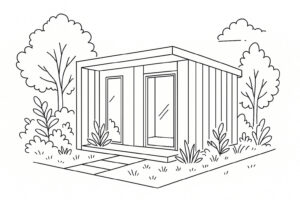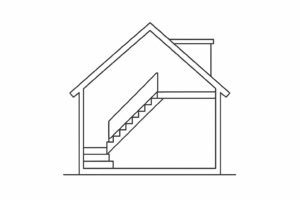Frequently Asked Questions
How much value will an extension add to my house?
While this varies, a well-designed extension almost always adds more value to a property than it costs to build. Kitchen-diner extensions are particularly valuable. It’s a fantastic investment that also gives you more space to enjoy.
How will you ensure the new extension matches my existing house?
We take great care to match new materials, such as bricks and roof tiles, to your original property. Our goal is to make the extension look like a natural part of your home, rather than an obvious addition.
Will the building work be very disruptive?
What is the difference between a single-storey and a two-storey extension?
A single-storey extension adds a room or rooms on the ground floor only. A two-storey extension adds rooms on both the ground floor and the first floor, often creating a new bedroom and bathroom above a new kitchen or living area, offering maximum space for a similar footprint.
Can you install large bi-fold or sliding doors?
Do I need an architect?
For a complex extension, an architect is highly recommended to produce detailed drawings. For more straightforward projects, we can often work with you directly or with a more affordable architectural technician to produce the necessary plans for planning and building control.
What are Building Regulations and do they apply to my extension?
Building Regulations are minimum standards for design, construction, and alterations to virtually every building. They are completely separate from planning permission and are essential for ensuring safety and energy efficiency. All our extension work is fully compliant and will be signed off by a local authority or approved inspector.
Can you build an extension on a terraced house?
Yes, we frequently build extensions on terraced properties. This requires careful logistical planning for access and material storage, as well as adherence to the Party Wall Act to ensure your neighbours are formally notified and protected.
Will a loft conversion make my house colder?
On the contrary, a professionally insulated loft conversion can make your home more energy-efficient. We install high-performance insulation that meets or exceeds current building regulations, which helps to reduce heat loss through your roof and can lower your energy bills.
Where will the new staircase for the loft go?
The placement of the staircase is crucial. We aim to position it so that it feels like a natural part of your home, often placing it above your existing staircase to minimise the loss of space on the floor below. We will design the most efficient and compliant layout during the survey.
Do I need to inform my neighbours about my loft conversion?
Can you install an en-suite bathroom in the loft?
Yes, adding an en-suite is a very popular and practical feature for a new loft bedroom. We can handle all the necessary plumbing and electrical work to create a stylish and functional bathroom in your new space.
Is my existing boiler suitable for a new loft bathroom?
Will I need to have my water tank moved?
If you have an older, gravity-fed system with a large water tank in the loft, then yes, it will need to be moved or, more commonly, replaced. This is a perfect opportunity to upgrade to a modern, unvented cylinder or a combi boiler, which frees up space and improves your home’s hot water performance.
Is a loft conversion a noisy and disruptive process?
There will be some noise, particularly during the initial structural stages. However, we carry out most of the early work from scaffolding on the outside of your house. We only break through to install the staircase towards the end of the project, which significantly minimises disruption to your daily life.
What is the difference between a Dormer and a Velux conversion?
A Velux (or rooflight) conversion is the simplest type, where windows are fitted into the existing roof slope. A Dormer conversion involves building a structural extension that projects vertically from the roof, creating more headroom and usable floor space. We can advise on the best option for your home and budget.
How long does a typical loft conversion take?
A straightforward Velux conversion might take 4-6 weeks, while a more complex Dormer conversion could take 8-12 weeks. We will provide a detailed project timeline before any work begins.
How long does a typical home renovation take?
The timescale depends on the size and complexity of the project. Smaller renovations, such as updating a single room, may take just a few weeks, while full property refurbishments or structural alterations can take several months. At the start, we provide a detailed schedule so you know exactly what to expect, and we keep you informed throughout to ensure there are no surprises.
Do I need planning permission?
Most internal renovations do not require planning permission, as they fall under permitted works. However, if your project involves structural alterations, extensions, or changes to the external appearance of your property, approval may be necessary. We offer guidance on this process and, where needed, liaise directly with your local authority to ensure everything is carried out correctly.
Can you work on listed buildings?
Could you help with the design stage?
Yes. We don’t just build – we also help plan and design your renovation. Our team can advise on layout, materials, lighting and finishes, working closely with architects and designers if needed. The aim is to make sure your home not only looks beautiful but functions perfectly for everyday living.
Do you manage all trades?
Will I need to move out?
How long does a typical kitchen renovation take?
A standard kitchen renovation, from removal of the old units to the final touches on the new one, typically takes between 2 to 4 weeks. This can vary depending on the complexity, such as whether structural walls are being removed or the layout is being significantly changed.
Will I be without cooking facilities for the entire time?
You will be without your main kitchen for the majority of the project. However, we work to minimise this disruption. We can often set up a temporary kitchenette for you in another room with your microwave, kettle, and perhaps your old fridge, to make the process more manageable.
Can you remove a wall to create an open-plan kitchen-diner?
Yes, absolutely. Creating open-plan living spaces is a very common request and a core part of our service. We manage the entire process, from the structural engineer’s calculations for the correct steel beam (RSJ) to the installation and plastering, ensuring it is all fully compliant with building regulations.
Do I have to buy my kitchen from your suppliers?
Not at all. We offer a flexible service. We can supply a high-quality kitchen through our trusted trade partners, or we can provide a professional ‘installation-only’ service if you have already purchased your kitchen from a supplier like Howdens, Wren, or Magnet.
Do you manage all the trades, like plumbers and electricians?
Can you help me with the design and layout?
Yes. Good design is key to a successful kitchen. We can provide expert advice on the most effective layout to maximise your space, improve workflow, and incorporate clever storage solutions. We’ll help you plan everything from lighting schemes to appliance placement.
Can you install underfloor heating?
Yes, a kitchen renovation is the perfect time to add the luxury and efficiency of underfloor heating. We can install both electric mat systems, which are great for renovations, and water-based systems if you are undertaking a larger project or extension.
How long will I be without a functioning bathroom?
We understand the inconvenience this can cause. For a full renovation, the bathroom may be out of use for 5 to 10 working days. We work efficiently to minimise this period and will always keep you updated. If you don’t have a second bathroom, we can discuss temporary solutions.
Do you supply the bathroom suite and tiles?
We can do either. We have established relationships with excellent local suppliers and can source and supply everything for you. Alternatively, if you have already purchased your own suite, tiles, and fittings, we are happy to provide an installation-only service.
Can you create a wet room in a small bathroom?
Yes, wet rooms are a fantastic way to maximise space and create a sleek, modern look. We are experts in waterproofing (tanking) and drainage to ensure your wet room is both stylish and completely watertight.
What can be done about poor ventilation and mould in my bathroom?
Proper ventilation is key. We always install powerful, quiet extractor fans that are ducted to the outside to effectively remove moist air. This, combined with mould-resistant paint and grout, will solve condensation and mould issues for good.
Can you move the position of the toilet, sink, or bath?
Do you do all the tiling and flooring?
Yes, we provide a complete service. Our team includes skilled tilers who can work with everything from ceramic and porcelain to natural stone. We also install a range of waterproof flooring options, including luxury vinyl tile (LVT) and traditional floor tiles.
Can you fit underfloor heating?
Underfloor heating is a fantastic luxury addition to any bathroom renovation and is very energy-efficient for heating the space. We can install both electric and water-based (if connected to central heating) underfloor heating systems.
Do you take away all the old bathroom fixtures and rubbish?
Yes, we do. Our quote includes the responsible disposal of all waste materials from your old bathroom and the construction process. We will leave your home clean and tidy, with your new bathroom ready to use.
How long does a garage conversion usually take?
Most garage conversions take 3 to 6 weeks, depending on the size of the garage and the scope of work. A simple conversion with basic insulation and finishes is quicker, while projects involving plumbing, electrics or structural changes take longer. We’ll always provide you with a clear timescale before starting.
Do I need planning permission for a garage conversion?
In most cases, planning permission is not required, as garage conversions usually fall under permitted development. However, if your property is listed, in a conservation area, or if you are changing the exterior significantly, permission may be needed. We can advise you and, if necessary, handle the application with your local authority.
Will my garage conversion meet building regulations?
Yes, all garage conversions must comply with UK building regulations, covering insulation, ventilation, fire safety and electrics. We liaise with building control on your behalf and ensure the new space is safe, efficient and fully certified once completed.
Can part of my garage remain as storage?
Yes, part-conversions are very popular. Many clients choose to convert the rear of the garage into a living area, bathroom or office while keeping the front for bicycles, tools or machinery. This is a cost-effective option that gives you the best of both worlds.
What types of rooms can a garage be converted into?
A converted garage can become almost any type of room – a home office, guest bedroom, playroom, utility room, gym, cinema room or even a kitchen. We’ll help you choose the best use of the space to suit your property and lifestyle.
How long does a patio or decking project take?
Most projects are completed within 1 to 3 weeks, depending on size and complexity. We’ll always give you a clear timescale before starting.
Do I need planning permission for decking or patios?
In most cases, no. Patios, paving and decking are normally covered by permitted development. If permission is needed, we’ll guide you through the process.
Can you work with uneven or sloping gardens?
Yes. We can level ground, build steps or create split-level terraces. Careful design ensures even tricky gardens are practical, safe and attractive.
Do you handle drainage and groundwork?
Yes. Proper drainage and groundwork are key to a long-lasting patio or driveway. We take care of everything, ensuring your new outdoor area is safe, solid and built to last.
How durable are patios and decking in the UK climate?
We design and build with durability in mind, ensuring your outdoor space withstands year-round weather. With proper care, it will stay functional and attractive for many years.
Will the work cause disruption to my home?
Some ground preparation is required, but we keep disruption to a minimum. Our team work efficiently and leave the site tidy and ready to enjoy.
Do I need planning permission for a garden room?
In most cases, no. Garden rooms often fall under ‘Permitted Development’ rights, provided they meet certain criteria regarding size, height, and distance from your property boundary. We will assess your specific situation and advise you on whether any permissions are needed.
Can I have a toilet or kitchenette installed in my garden room?
Yes, we can incorporate plumbing for a small bathroom or a simple kitchenette. This requires more extensive groundwork to connect water and waste services, but it’s a great way to create a fully self-contained space.
What kind of base is required for a garden room?
A solid, level base is essential for the longevity of your garden room. We typically recommend either a concrete slab or a ground screw foundation system. We will assess your garden’s ground conditions and advise on the most suitable and cost-effective option.
Are your garden rooms insulated for year-round use?
Absolutely. We build our garden rooms to be used comfortably throughout the year. They are fully insulated using high-quality materials in the floor, walls, and roof, and we fit double-glazed windows and doors as standard.
Can you connect electricity and internet to the garden room?
How secure are your garden rooms?
Our garden rooms are fitted with high-quality, insurance-approved locks on all doors and windows as standard. The double-glazed units are also internally beaded, which prevents them from being removed from the outside.
Can you build a garden room that is attached to my house?
While a detached garden room is a standalone structure, we can certainly build an attached garden room. This would be classified as a house extension and would need to comply with building regulations for thermal efficiency and fire safety between the two structures.
Do you offer different options for exterior cladding?
Yes, we offer a wide range of cladding to suit your style and budget. Popular choices include natural woods like cedar and larch for a warm, traditional look, as well as low-maintenance composite cladding which comes in various colours and finishes.




